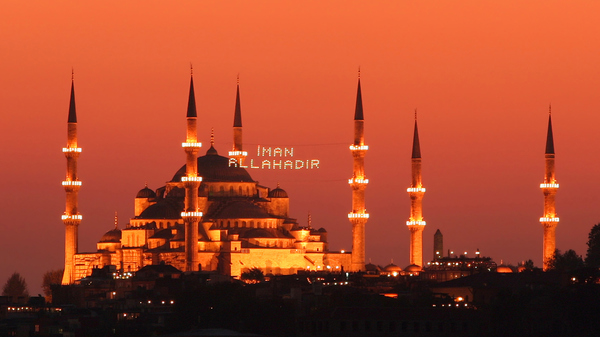Ramadan Fasting
During Ramadan, Muslims fast from sunrise to sunset. There are strict rules governing the Ramadan fast—but there are exceptions.

The Fatih Mosque in Istanbul is illuminated during Ramadan fasting; the message says “faith is present” in Arabic.
© iStockphoto.com/anilakduygu
Why Are Muslims Fasting?
During the holy month of Ramadan, Muslims fast for 30 days until the day of Eid al-Fitr. Fasting is considered one of the Five Pillars of Islam, obligatory acts of worship for every Muslim. The other pillars are: testifying to God and the Prophet (shahada), praying (salat), giving money to the poor (zakah), and making the pilgrimage to the sacred Arabic city of Mecca (hajj).
When does Ramadan start this year?
When Should Muslims Fast?
Muslims fast from dawn until dusk. According to the Quran, dawn is the time when “the white thread of dawn appears to you distinct from its black thread.” The fasting ends when “the night appears” (Quran, verse 187).
Sunni Muslims generally break the fast as soon as the disk of the Sun has sunk below the horizon, even when there is still light in the sky. Shia Muslims generally wait until it gets completely dark before they break the fast.
Sunrise and sunset times for your location
Meals During Ramadan
During the fasting period of Ramadan, Muslims traditionally take two fixed meals: A morning meal called Sahur, usually eaten half an hour before dawn; and Iftar, the fast-breaking meal immediately after sunset. Following the tradition of the Prophet Muhammad, Muslims break the fast with eating dates.
During the night, after the fasting hours, Muslims can eat snacks if they want. Drinking water at night is important, especially during the summer months, and is encouraged by Islamic authorities.

A Muslim family breaks the fast with the traditional meal after sunset, the Iftar.
© iStockphoto.com/nazar_ab
Ramadan Fasting: What Is Allowed, What Is Forbidden?
Islamic holy scripture and law is quite particular about which activities are allowed during Ramadan and which are prohibited. The following list applies to the time from dawn until dusk:
| Allowed | Forbidden |
| Showering and bathing | Eating, drinking, and smoking |
| Using eye drops, contact lenses, and perfumes | Deliberately causing yourself to vomit |
| Taking injections or blood tests | Women with menstrual and post-childbirth bleeding cannot take part in the fast. |
| Brushing teeth and using toothpicks | Sexual intercourse and masturbation. Kissing between husband and wife is allowed, but should be avoided. |
Exceptions from Fasting
Every adult Muslim who is sane and healthy has to fast during Ramadan according to Islamic tradition. These are the exceptions:
- If a Muslim is sick during Ramadan, he or she can skip the fasting. However, they have to fast later, when they are healthy again, to complete the days they missed.
- The same is true for pregnant and menstruating women, and women who are nursing. They should postpone fasting and perform it later.
- People with a chronic illness and people who are mentally unfit for fasting may also skip Ramadan. However, they must pay the fidyah instead—they give a day’s meal to a needy person for each day they did not fast themselves.
- The last exception is travel: Muslims who are traveling during Ramadan can skip fasting if they travel for a good cause and if they travel at least 48 miles (80 km) away from their city of residence. Travelers have to make up the missed days after their travel.
Ramadan Fasting in the Arctic
Muslims have to fast during daylight hours. But what if the Sun never sets? Muslim communities in the far north of Norway, Sweden, and Canada, have some experience with this. Every year, they live through many months where the Sun never sinks below the horizon.

The Midnight Sun over northern Norway never sets. What does this mean for Ramadan fasting?
©bigstockphoto.com/harvepino
How are these communities dealing with the Ramadan rules? Since every Muslim community can make their own rules about fasting, they have come up with different strategies:
1. Use the Last Clear Sunset Time
Sweden’s Islamic Association, for example, recommends following the last clear sunset time—the last time the Sun clearly sank below the horizon—and use this as a guideline during Ramadan.
2. Follow Mecca Times
The Muslim community in Tromsø in northern Norway followed the sunrise and sunset times of Mecca. As the Sun rose at 05:00 (5 am) in Mecca, the Norwegian community started fasting as well. Following the fasting times from a religious center of Islam like Saudi Arabia or Turkey is not uncommon for Muslim communities.
3. Follow the Nearest Community
The community in Iqaluit, Canada, found a third solution: They followed the nearest Muslim community outside the Arctic circle and did not experience a Midnight Sun. In their case, this was the Muslim community in Ottawa.